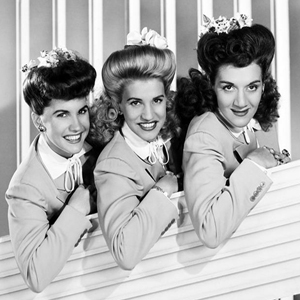
A Legacy of Harmony and Swing
The Andrews Sisters
Introduction
The Andrews Sisters were one of the most successful and beloved American close harmony singing groups of the 20th century. Comprising LaVerne, Maxene, and Patty Andrews, they became international stars during the swing and boogie-woogie era of the 1930s and 1940s. Their tight vocal harmonies, energetic performances, and infectious enthusiasm made them a favourite among audiences worldwide.
Early Years
Born in Minnesota, the three sisters—LaVerne (1911), Maxene (1916), and Patty (1918)—were influenced by the harmonies of the Boswell Sisters, a popular jazz trio. They honed their craft as children and performed locally before moving to New York to pursue a professional career. Their big break came in 1937 when they signed with Decca Records and recorded "Bei Mir Bist Du Schön," their first major hit.
 Rise to Fame
Rise to Fame
Throughout the late 1930s and 1940s, The Andrews Sisters dominated the charts with their unique blend of swing, jazz, and boogie-woogie. They recorded hundreds of songs, including:
- "Boogie Woogie Bugle Boy"
- "Don't Sit Under the Apple Tree"
- "Rum and Coca-Cola"
- "Beer Barrel Polka"
Their music resonated particularly with soldiers during World War II, as they performed extensively for the USO, boosting morale at home and abroad. Their lively and spirited performances made them a symbol of the war effort.
Hollywood and Radio Success
Beyond music, The Andrews Sisters also found success in Hollywood. They appeared in over a dozen films, often alongside major stars such as Bing Crosby, Bud Abbott & Lou Costello, and Bob Hope. Their movies, including Buck Privates (1941) and Follow the Boys (1944), further solidified their place in American entertainment.
The trio also became a staple on radio programs, performing regularly with Crosby and other big band legends. Their collaborations brought about some of their most enduring songs, including the wartime favourite "Ac-Cent-Tchu-Ate the Positive."
 Post-War Career and Challenges
Post-War Career and Challenges
After World War II, musical tastes changed, but The Andrews Sisters remained popular. However, tensions between the sisters grew, leading to a brief disbandment in the early 1950s when Patty pursued a solo career. They reunited in 1956 and continued performing together, albeit with less commercial success than in their heyday.
Following LaVerne's passing in 1967, Maxene and Patty attempted to keep the act going, but the strain on their relationship led to a permanent split. Despite their struggles, their contributions to music remained widely recognized.
Legacy and Influence
The Andrews Sisters' influence on music is undeniable. They set the standard for vocal harmony groups and paved the way for future acts, including The McGuire Sisters, The Supremes, and even modern groups like The Puppini Sisters. Their songs continue to be covered, and their impact on swing, jazz, and pop music endures.
In recognition of their contributions, The Andrews Sisters were awarded a star on the Hollywood Walk of Fame and inducted into the Vocal Group Hall of Fame. Their music remains a beloved part of American cultural history.
Conclusion
With their distinctive sound, boundless energy, and a legacy that transcends generations, The Andrews Sisters remain one of the greatest vocal groups of all time. Their harmonies defined an era and continue inspiring musicians and fans alike.






